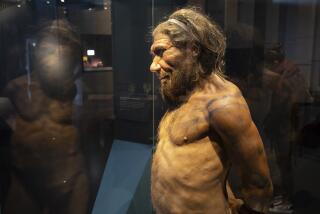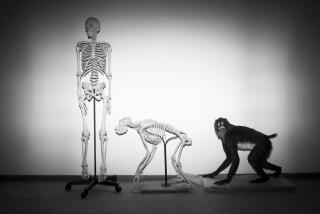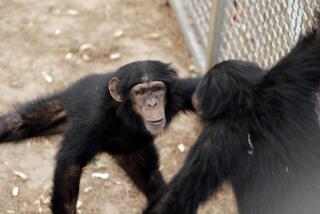Evolve or die: Why our human ancestors learned to be social more than 320,000 years ago
New discoveries in eastern Africa suggest that human behaviors like symbolic thought and the creation of extended social networks were established at least 320,000 years ago — tens of thousands of years earlier than previously thought.
The work, published as a trio of papers Thursday in Science, sheds new light on the often murky story of when our ancestors first started acting like humans, and why, experts said.
“What we are seeing is a complex set of developments that may represent new ways of surviving in an unpredictable environment,” said Rick Potts, a paleoanthropologist and director of the Smithsonian’s Human Origins program. “It is a package we didn’t know occurred so early, and right at the root of our species.”
For more than 30 years, Potts has led excavations in southern Kenya at a site known as the Olorgesailie Basin, which was occupied by hominids for more than 1 million years.
The 50-square-mile area has yielded a sequence of stone tools that date back as far as 1.2 million years, allowing researchers to see how human technology and behavior has changed over time.
The authors found that for roughly 700,000 years, from 1.2 million to 499,000 years ago, the hominids who populated this basin relied almost entirely on one simple, all-purpose stone tool known as a hand ax. It was generally between 4 and 10 inches long, shaped like a teardrop and chipped all the way around.
Anthropologists believe this basic hand ax was used for a variety of purposes, including cutting through joints of large animals, chopping down trees and digging in the ground for roots, tubers or water.
“It was very successful for a long period of time when fluctuations in the environment were somewhat modest,” Potts said. “Then all hell broke loose.”
Geological evidence from the site indicates that around 499,000 years ago, the region experienced tremendous upheaval. Volcanic activity increased, and new faults developed in Earth’s crust. This led to earthquakes that destroyed the ancient lake basin and pushed it up out of the ground. Because of this, there is a gap in the archaeological record of about 180,000 years when no new sediments were laid down at the site.
Over time, however, wind and rain caused river channels to form in what once was the lake basin, and eventually new sediment layers began to form. These processes led to a more recent set of archaeological data that starts about 320,000 years ago and continues until 3,000 years ago.
When Potts and his colleagues began excavating the newer material from the river channels, they found that hominid behavior at the Olorgesailie Basin had changed completely between the time the lake sedimentation ended and the river sedimentation began.
For example, the hand axes had been replaced by smaller, more sophisticated tools that could be attached to sticks and hurled through the air. In addition, the team found that some of the obsidian rock used to make the new tools came from 25 to 30 miles away. In the older sediments, nearly all the material used to create tools originated within 5 miles of the site.
Alison Brooks, a paleoanthropologist and Paleolithic archaeologist at George Washington University who contributed to the new work, said it is unlikely that hunter and gatherer societies of that time period would have been able to travel such great distances to procure materials for their weapons.
Instead, the discovery of the transported obsidian suggests that as early as 320,000 years ago, hominids had established social networks that allowed them to exchange gifts with groups from more distant lands, she said. In addition, these relationships could have been strong enough for individuals to turn to their neighbors in times of need.
“Social networks are an extremely important part of early human societies,” Brooks said. “Pastoralists can store food or add cattle to their herds, but for hunter-gatherers, the only way to save for a rainy day is to have friends in distant places.”
The researchers also found evidence that these socially connected hominids were making pigments from rocks, which implies they were sophisticated enough to be capable of symbolic thought. This might have made communication between disparate groups easier.
The authors suggest these new behaviors were not the inevitable result of evolution, but rather a response to massive geological and climate changes that began about 500,000 years ago. Indeed, the fossil record from the site indicates that between 499,000 and 320,000 years ago, 85% of the region’s animals became extinct and were replaced by new lineages and entirely new species.
“That may seem peripheral, but to us, it was pretty central,” Potts said. “It meant that it wasn’t just the humans changing — there was a very big evolutionary picture going on.”
Potts believes that the new suite of human behaviors observed after the 320,000-year mark emerged as a way to cope in an environment that had become less predictable.
Perhaps the only way to make a successful living in this more challenging landscape was for our ancestors to learn to make better tools, create extended networks of friends and learn to communicate with them, he said.
In other words: Evolve or die.
“There are those who rose to the challenge, but there were likely many more who didn’t,” Potts said. “Our family tree is littered with dead branches and ways of life that no longer exist.”
Michael Petraglia, an anthropologist at the Max Planck Institute for the Science of Human History in Germany who was not involved in the research, said the new work offers an important window into the habitats and behaviors of hominids at a critical time in human evolution.
“This has been a murky and poorly known period,” he said. “It is very rare to have well-dated stone tools in association with animal remains and environmental information.”
Martin Ziegler, a paleoclimatologist at Utrecht University in the Netherlands, agreed.
“In particular, the dating of these archaeological records appears to be of very high quality,” he said. “This is extremely important, since a good chronology is the basis for any evaluation of potential links between human evolutionary events and climate or environmental change.”
But while anthropologists applauded the work, they also lamented the gaping 180,000-year break in the Olorgesailie Basin’s timeline.
“Unfortunately, there is a large chronological gap between 500,000 years ago and 320,000 years ago,” Petraglia said. “We need to know more about this period of time, and that can only come through investigations of other sites.”
Shannon McPheron, a Paleolithic anthropologist also at Max Planck, put it this way: “Papers like these now increase the importance of finding additional sites that can speak to changes in environment, biology and behavior just prior to this.”
The study authors are also hopeful that future discoveries will fill in these holes.
“What we are dealing with here is a larger question,” Brooks said. “Did we become human gradually, or did we become human suddenly? We don’t know because so far, we don’t have the piece in the middle.”
Do you love science? I do! Follow me @DeborahNetburn and “like” Los Angeles Times Science & Health on Facebook.
MORE IN SCIENCE
Study on Arctic warmth and winter weather across the U.S. draws heated debate
With healthcare, it’s not what you spend but how you spend it
This is ‘nanowood,’ a new invention that could greatly reduce humanity’s carbon footprint







